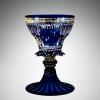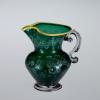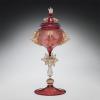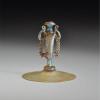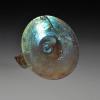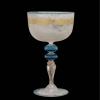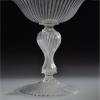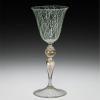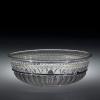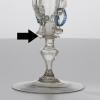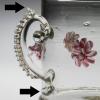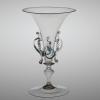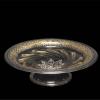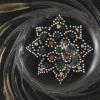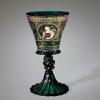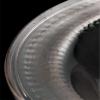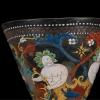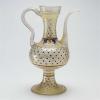Appendices
Figures
FIG. 1
The Reference Collection: 35 Corning Museum of Glass objects selected to illustrate most of the structure- and decoration-producing techniques used in Renaissance Venetian glassworking. View all objects in the Visual Guide to Objects and Techniques.
FIG. 2
The earliest closely datable inflated glass artifacts: blue glass tubes with one end blown bulbous. Mid-first century B.C. The Israel Museum, Jerusalem. Photo: The Corning Museum of Glass, with the permission of Hillel Geva, Israel Exploration Society.
FIG. 3
The earliest closely datable inflated glass artifacts: narrow-necked bottles with striped decoration. Mid-first century B.C. The Israel Museum, Jerusalem. Photo: The Corning Museum of Glass, with the permission of Hillel Geva, Israel Exploration Society.
FIG. 4
The Ein Gedi bottle. Mid-first century B.C. H. about 12.7 cm. The Israel Museum, Jerusalem. Photo: © The Israel Museum, Jerusalem/by Peter Lany.
FIG. 5
Fresco, still life with peach branch. Roman Empire, Pompeii, first century A.D. Museo Archeologico Nazionale, Naples. Photo: De Agostini Picture Library / G. Nimatallah / Bridgeman Images.
FIG. 6
Ribbon flask. Roman Empire, first century A.D. H. 9 cm. The J. Paul Getty Museum, Los Angeles (2003.276). Photo: The J. Paul Getty Museum.
FIG. 7
Cup with gladiators. Roman Empire, first century A.D. H. 7.1 cm, D. (rim) 7.5 cm. The Corning Museum of Glass (54.1.84).
FIG. 8
Terra-cotta mold for an Ennion cup in The Corning Museum of Glass (66.1.36). The mold is thinly lined with soot. Reproduction made by David Hill, 2015. Photo: Mark Taylor, courtesy of David Hill.
FIG. 9
Flask with doves. Cologne, mid-third century. H. 24.5 cm. Römisch-Germanisches Museum der Stadt Köln (inv. no. 674). Photo: Rheinisches Bildarchiv Köln (RBA_mf140875).
FIG. 10
The “Masterpiece.” Cologne, second half of the third century. H. 27.5 cm, W. 16.0 cm. Römisch-Germanisches Museum der Stadt Köln (inv. no. 541). Photo: Rheinisches Bildarchiv Köln (RBA_d030714_1).
FIG. 11
Verre des Augustins. France, late 14th century. H. 17.8 cm. Musée Départemental des Antiquités, Rouen (1959.4-14.1). Photo: Musée Départemental des Antiquités, Rouen (cg76); © Yohann Deslandes.
FIG. 12
San Marco Bowl, gilded, enameled. Byzantine, probably 10th century. H. 17 cm, D. 17 cm. Treasury of San Marco, Venice (109). Photo: Cameraphoto Arte, Venice / Art Resource, NY.
FIG. 13
The Palmer Cup, gilded, enameled. Islamic, possibly Syria or Egypt, early 12th century. H. 26.3 cm; D. (rim) 13.2 cm, (base) 12 cm. The British Museum, London (WB.53). Photo: © The Trustees of The British Museum (WB.53AN1501269001).
FIG. 14
The Aldrevandin Beaker. Probably Venice, about 1330. H. 13 cm, D. 10.9 cm. The British Museum, London (1876,1104.3). Photo: © The Trustees of The British Museum (1876.1104.3AN32286001).
FIG. 15
Fragment of heraldic beaker, found in goldsmith’s quarter of London at 7–10 Foster Lane. Probably Venice, about 1290–1325. H. 9.5 cm, D. 8.8 cm. Museum of London (OST82[190]<128>). Photo: © Museum of London.
FIG. 16
Three soffiettas. The two on the left were made by Carlo Dona of Murano, and the one on the right was made by William Gudenrath. Photo: Harry Seaman, The Studio of The Corning Museum of Glass.
FIG. 17
The process of forming the upper half of a beaker like the Palmer Cup, using only jacks (shown in Figures 17–21), begins with forming the lower half of the vessel, attaching it to a pontil, and removing it from the blowpipe. Photos for Figures 17–29 are from William Gudenrath, “Glassblowing in the Middle Ages: Tradition and Innovation,” in David Whitehouse, with contributions by William Gudenrath and Karl Hans Wedepohl, Medieval Glass for Popes, Princes, and Peasants, Corning: The Corning Museum of Glass, 2010, pp. 78–82, figs. 6–18.
FIG. 18
The upper half of the vessel is reheated and softened in the furnace.
FIG. 19
While the pontil is turned, the jacks are used to expand the sides.
FIG. 20
FIG. 21
The working cycle of reheating and shaping continues until the beaker has been completed. (Tool marks left from the jacks can be seen covering the interior of the beaker.) The finished object is removed from the pontil and annealed.
FIG. 22
The process of forming the upper half of a beaker using both jacks and the soffietta (shown in Figures 22–29) begins with forming the lower half of a vessel like the Aldrevandin Beaker, attaching it to a pontil, and removing it from the blowpipe.
FIG. 23
The upper third of the vessel is reheated and softened in the furnace.
FIG. 24
While the pontil is turned, the jacks are used to enlarge the diameter of the opening to about an inch (2.5 cm).
FIG. 25
FIG. 26
The soffietta is used to expand the softened sides by inflation.
FIG. 27
After the upper quarter of the vessel is reheated, the opening is enlarged to a diameter of about two inches (5 cm).
FIG. 28
While the glass is still soft, the soffietta is employed to further expand the upper quarter of the beaker. (Note that the shaping with the soffietta leaves no tool marks on the glass.)
FIG. 29
After the upper part is reheated, the jacks are used to give the final shape to the upper eighth or so of the vessel. (Tool marks left by the jacks can be seen only in the immediate vicinity of the rim.) The finished object is removed from the pontil and annealed.
FIG. 30
Still life with crystal goblet, fruit, violin, and parrot. Gabriele Salci (active in the early 18th century), 1710–1720. Palais Liechtenstein, Vaduz. Photo: LIECHTENSTEIN. The Princely Collections, Vaduz-Vienna.
FIG. 31
Glass goblets decorated with polychrome enamel. Venice, Muranese glass factory, about 1708. Rosenborg Castle, Copenhagen, Danske Kongers Kronologiske Samling. Photo: De Agostini Picture Library / Bridgeman Images.
FIG. 32
Covered goblet decorated with the reticello technique. Probably Venice, late 17th–early 18th century. H. 27.7 cm, D. (cover) 9.5 cm. The Corning Museum of Glass (79.3.174, gift of The Ruth Bryan Strauss Memorial Foundation).
FIG. 33
The Rothschild Bowl, opaque white glass with gold and enamel decoration. Venice, about 1500–1510. H. 5.9 cm, D. (rim) 14.1 cm, (foot) 6.3 cm. The Corning Museum of Glass (76.3.17, purchased with funds from the Museum Endowment Fund).
FIG. 34
Plate, opaque white glass enameled with a view of the Church of the Carita, Venice. Probably Venice, Miotti glasshouse, 1741. D. (rim) 22.4 cm. The Corning Museum of Glass (66.3.38).
FIG. 35
Covered beaker, calcedonio glass. Europe, 18th century. OH. 17.6 cm, H. (beaker) 12.3 cm; D. (beaker) 8.4 cm, (cover) 9 cm. The Corning Museum of Glass (79.3.487, bequest of Jerome Strauss).
FIG. 36
Bottle in filigrana policroma. Venice, Murano, about 1846. Museo del Vetro, Murano. Photo: 2015 © Photo Archive—Fondazione Musei Civici di Venezia.
FIG. 37
Glass furnace, showing the upper annealing chamber. Vannoccio Biringuccio (Italian, 1480–1539). In De la pirotechnia, [Venice], 1540. Rakow Research Library, The Corning Museum of Glass (93699). Photo: The Corning Museum of Glass.
FIG. 38
Glass furnace, with annealing furnace attached. Georg Agricola (German, 1494–1555). In De re metallica, Basel, 1556. Rakow Research Library, The Corning Museum of Glass (93693). Photo: The Corning Museum of Glass (24020).
FIG. 39
Glass furnace, with workers. Georg Agricola (German, 1494–1555). In De re metallica [Berckwerck Buch, Frankfurt-am-Main, 1580, p. cccxc]. Rakow Research Library, The Corning Museum of Glass (66820). Photo: The Corning Museum of Glass.
FIG. 40
The Medici Glass Workshop (detail). Giovanni Maria Butteri (Italian, 1540–about 1606), 1570. Palazzo Vecchio, Studiolo of Francesco I. Photo: Scala / Art Resource, NY.
FIG. 41
The Annunciation of the Virgin, oil on canvas. Paolo Veronese (Italian, 1528–1588), 1578. H. 279 cm, W. 551 cm. Gallerie dell’Accademia, Venice. Photo: Alinari / Art Resource, NY.
FIG. 42
“Glassworking at a Wood-Fired Furnace.” Denis Diderot (French, 1713–1784). In Encyclopédie [Selections], 1751–1772. Corning, New York: Corning Glass Center, n.d. Rakow Research Library, The Corning Museum of Glass (67353). Photo: The Corning Museum of Glass.
FIG. 43
The Rothschild Bowl, opaque white glass with gold and enamel decoration. Venice, about 1500–1510. H. 5.9 cm, D. (rim) 14.1 cm, (foot) 6.3 cm. The Corning Museum of Glass (76.3.17, purchased with funds from the Museum Endowment Fund).
FIG. 44
The Turquoise Goblet. Venice, about 1500. H. 18.9 cm. The British Museum, London (WB.55). Photo: © The Trustees of The British Museum (WB.55AN1537486001).
FIG. 45
Armorial goblet, blown, mold-blown, tooled, enameled, gilded. Venice, possibly 1480–1490. H. 19.7 cm, D. (rim) 13.3 cm, (foot) 13.4 cm. The Corning Museum of Glass (79.3.193, bequest of Jerome Strauss).
FIG. 46
Jug, blown, engraved, tooled, applied. Venice, 1675–1725. H. 10.1 cm, D. 7.8 cm. The Corning Museum of Glass (50.3.8).
FIG. 47
Winged goblet, blown, applied, tooled. Probably Venice, 17th century. H. 17.3 cm, W. 11.1 cm, D. (foot) 11 cm. The Corning Museum of Glass (2000.3.13).
FIG. 48
Ewer, calcedonio glass. Venice, about 1500–1525. H. 30 cm, D. (rim) 8 cm. The Corning Museum of Glass (2001.3.56, gift of Robert and Deborah Truitt).
FIG. 49
Beaker, translucent opalescent lattimo glass. Venice, 17th century. H. 9.3 cm, D. (rim) 7.4 cm. The Corning Museum of Glass (71.3.171, gift of Jerome Strauss).
FIG. 50
FIG. 51
FIG. 52
An example of disbursed gold covering most of the blown surfaces of a Venetian object made after 1860. The Corning Museum of Glass (62.3.118).
FIG. 53
An example of iridescence resulting from the long-term burial of a 17th-century façon de Venise goblet fragment. Probably Low Countries. Private collection.
FIG. 54
An example of iridescence resulting from chemicals (stannous chloride?) having been sprayed on the hot glass during the last stages of manufacture. Made after 1860. Private collection.
FIG. 55a
FIG. 55b
A selection of later Venetian goblets, illustrating a pattern of heavier weight. Private collection.
FIG. 56
Lower surface of the foot of a 16th-century goblet, showing a typical punty mark. Private Collection.
FIG. 57
Crown-type punty mark on a Venetian object made after 1860. The Corning Museum of Glass (73.3.440).
FIG. 58
Venetian goblet made in the 16th or 17th century, showing “start/stop” tool marks. (These are very difficult to see in photographs). The Corning Museum of Glass (67.3.48).
FIG. 59
FIG. 60
Venetian goblet made after 1860, showing increase in wall thickness of lowermost stem, where the diameter is reduced; also showing “chicken-leg” form of stem, and attachment of foot to edge of merese. The Corning Museum of Glass (93.3.61).
FIG. 61
Venetian goblet made after 1860, showing increase in wall thickness of lowermost stem, where the diameter is reduced; also showing “chicken-leg” form of stem, and attachment of foot to edge of merese. Private collection.
FIG. 62
Venetian goblet made after 1860, showing increase in wall thickness of lowermost stem, where the diameter is reduced; also showing “chicken-leg” form of stem, and attachment of foot to edge of merese. The Corning Museum of Glass (66.3.64).
FIG. 63
FIG. 64
Lower surface of foot of 16th-century Venetian goblet, showing “deep, gouging” tool marks. The Corning Museum of Glass (67.3.48).
FIG. 65
Venetian bowl of about 1500, showing multiple elongated blister-type bubbles between two gathers of glass in mezza-stampatura decoration. The Corning Museum of Glass (60.3.2).
FIG. 66
Venetian goblet of the 16th or 17th century with “chain and scroll” decoration and “early,” smooth, fire-polished shear marks at lowermost parts of scrolls (see arrow). The Corning Museum of Glass (79.3.212).
FIG. 67
Venetian object, made after 1860, having “late,” sharp shear marks at lowermost part of handles, as well as at uppermost part of pincered decoration atop handles (see arrows). The Corning Museum of Glass (73.3.440).
FIG. 68
Venetian goblet of the 16th or 17th century with “chain and scroll” decoration, showing that all parts of this construction are flat and ribbonlike. The Corning Museum of Glass (79.3.212).
FIG. 69a
Footed platter with gently twisted mezza-stampatura , enameling, and gold-leaf decoration. Venice, late 15th to early 16th centuries. D. 26.3 cm. The Corning Museum of Glass (51.3.117).
FIG. 69b
Bottom of platter, showing gold-leaf and dot pattern in center, which sharply contrasts with decoration near rim; double pontil mark is also visible. The Corning Museum of Glass (51.3.117).
FIG. 70a
Nuptial goblet with polychrome enameled and gold-leaf decoration. The slight elongation of the enamel dots and the subtle, radially oriented breaking up of the gold-leaf decoration near the rim indicate that the diameter of the upper part of the object was slightly expanded when it was fired. Venice, late 15th century. H. 19.9 cm. The Corning Museum of Glass (79.3.170, bequest of Jerome Strauss).
FIG. 70b
Detail of goblet, showing double pontil mark on bottom (apex of foot). The second (or firing) pontil mark covers the lower three-quarters of the first mark, which was produced when the blank was made. The Corning Museum of Glass (79.3.170, bequest of Jerome Strauss).
FIG. 71
Detail showing upper, undecorated surface of enameled plate with gold-leaf decoration. The surface irregularities correspond to the presence or absence of enameled dots on the other side, indicating significant and prolonged softening of the vessel wall during the firing process (the rim area is similar to that of the footed platter shown in Figure 68a). Venice, late 15th to early 16th centuries. D. 24.1 cm. The Corning Museum of Glass (54.3.244).
FIG. 72
Conical footed beaker with polychrome enameled and gold-leaf decoration, viewed at the level of the rim. The areas with the greatest concentrations of enamel have produced localized thickening of the vessel wall that, in turn, resulted in the downward movement of the rim above them. Venice, late 15th to early 16th centuries. H. 13.3 cm. The Corning Museum of Glass (79.3.191, bequest of Jerome Strauss).
FIG. 73
Ewer with polychrome enameled and gold-leaf decoration. The handle at both the lower and upper attachment points sits atop the still clearly visible decoration. During the formation of the spout, the addition of molten glass re-softened the wall and its decoration was drawn out, striating the enamel dots. Venice, late 15th or early 16th century. H. 27.2 cm. The J. Paul Getty Museum, Los Angeles (84.DK.512). Photo: © J. Paul Getty Trust.
FIG. 74
Group of replicas (some of which may have been intended as forgeries) and objects imitating historical styles, decorated with polychrome enamels, gold leaf, and gold paint. None of these objects exhibits any evidence that the decoration was fired in a furnace while the piece was reattached to a pontil. A distinctly different process, and one that was only recently possible, was employed here. The decoration was fired while these objects sat in a kiln. H. (tallest) 41.1 cm. The Corning Museum of Glass (79.3.850, bequest of Jerome Strauss; 78.3.16, gift of Mr. and Mrs. Arthur Appleton; 66.3.13, gift in part of Edwin J. Beinecke; 96.3.13; and 79.3.339, gift of The Ruth Bryan Strauss Memorial Foundation).













![FIG. 15. Fragment of heraldic beaker, found in goldsmith’s quarter of London at 7–10 Foster Lane. Probably Venice, about 1290–1325. H. 9.5 cm, D. 8.8 cm. Museum of London (OST82[190]<128>). Photo: © Museum of London. FIG. 15. Fragment of heraldic beaker, found in goldsmith’s quarter of London at 7–10 Foster Lane. Probably Venice, about 1290–1325. H. 9.5 cm, D. 8.8 cm. Museum of London (OST82[190]<128>). Photo: © Museum of London.](https://renvenetian.cmog.org/sites/renvenetian.cmog.org/files/styles/thumbnail/public/london_000137_web.jpg?itok=JNFaONHR)





















![FIG. 37. Glass furnace, showing the upper annealing chamber. Vannoccio Biringuccio (Italian, 1480–1539). In De la pirotechnia, [Venice], 1540. Rakow Research Library, The Corning Museum of Glass (93699). Photo: The Corning Museum of Glass. FIG. 37. Glass furnace, showing the upper annealing chamber. Vannoccio Biringuccio (Italian, 1480–1539). In De la pirotechnia, [Venice], 1540. Rakow Research Library, The Corning Museum of Glass (93699). Photo: The Corning Museum of Glass.](https://renvenetian.cmog.org/sites/renvenetian.cmog.org/files/styles/thumbnail/public/93699_web_edited.jpg?itok=mTbgk7ys)

![FIG. 39. Glass furnace, with workers. Georg Agricola (German, 1494–1555). In De re metallica [Berckwerck Buch, Frankfurt-am-Main, 1580, p. cccxc]. Rakow Research Library, The Corning Museum of Glass (66820). Photo: The Corning Museum of Glass. FIG. 39. Glass furnace, with workers. Georg Agricola (German, 1494–1555). In De re metallica [Berckwerck Buch, Frankfurt-am-Main, 1580, p. cccxc]. Rakow Research Library, The Corning Museum of Glass (66820). Photo: The Corning Museum of Glass.](https://renvenetian.cmog.org/sites/renvenetian.cmog.org/files/styles/thumbnail/public/Rakow_1000061004_p490_crop_RGB-apd_web.jpg?itok=6pgB6mE4)


![FIG. 42. “Glassworking at a Wood-Fired Furnace.” Denis Diderot (French, 1713–1784). In Encyclopédie [Selections], 1751–1772. Corning, New York: Corning Glass Center, n.d. Rakow Research Library, The Corning Museum of Glass (67353). Photo: The Corning Muse FIG. 42. “Glassworking at a Wood-Fired Furnace.” Denis Diderot (French, 1713–1784). In Encyclopédie [Selections], 1751–1772. Corning, New York: Corning Glass Center, n.d. Rakow Research Library, The Corning Museum of Glass (67353). Photo: The Corning Muse](https://renvenetian.cmog.org/sites/renvenetian.cmog.org/files/styles/thumbnail/public/Rakow_200003385_p005_RGB.jpg?itok=b_Udwaf4)


